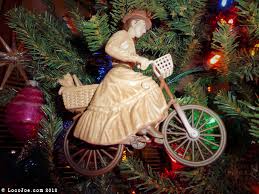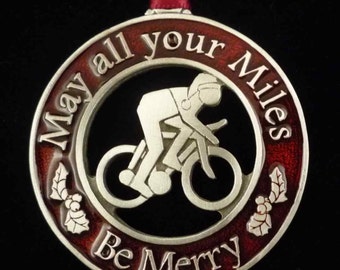Two weeks from today is Christmas Day.
I'll admit, I don't do much holiday decorating. Part of it has to do with time constraints: The holiday season coincides with the end of the semester. So, while other people are stringing lights and hanging globes and stars and such from trees, I'm grading papers, reading exams and explaining to students why they're not getting credit for a course in which they didn't attend half of the sessions and turned in the whole semester's work on the last day of class.
All right, I'll stop whining. I didn't do a lot of decorating even when I wasn't teaching. When I do have time, I'd rather ride, read, write or see people than to spend hours putting up things I'll have to take down a couple of weeks later.
Still, I sometimes like looking at other people's work and even admire some of those really over-the-top displays you can see in those New-York-City-in-name-only neighborhoods.
Then, of course, there are ornaments related to bicycles. Basically, they fall into two categories: those that are made to look like bicycles and those that are made from parts of actual bicycles. The latter category includes the sub-genre that might be called 1001 Uses For Bicycle Chains:


When ordering, be sure to specify 12, 11, 10, 9, 8/7/6/5 speed or 1/8".
In the category of ornaments that look like bikes (and riders), here are some interesting ones:
 |
| Add caption |
 |
| Add caption |
Now, this one isn't specifically a Christmas ornament:
but I believe it conveys the sentiment of this season:

Whenever I can, I volunteer with, donate to and buy from Recycle-A-Bicycle. They, like similar programs in other places, re-use old bikes and parts that might otherwise have ended up in landfills.
In my mind, bicycles and recycling are always linked. Perhaps that's because the time when I first became a dedicated cyclist--the 1970s Bike Boom--also witnessed the first attempts to make recycling a mainstream idea. The first Earth Day several years earlier got people (some, anyway) to thinking about the environment. People started using words like "ecology" and "pollution" in everyday conversations and started to see the value of things like emissions standards.
The problem was that both cycling and recycling became popular mainly among the young, the highly-educated and the upper-middle-class (or what someone I used to know called "The Volvo Set"). Blue-collar families and communities almost never included cyclists who were old enough to have drivers' licenses. Also, they, like many whose lives were day-to-day struggles to survive, saw recycling and environmentalism as trifles of the elite. So, when the oil-price shocks of the mid and late '70s sent gas prices to levels Americans had never before imagined, instead of cycling or walking to work or for errands, working-class people clung ever more tightly to their automobiles, and saw environmentalism and recycling as threats to their ever-more-precarious job security.

Ronald Reagan and his conservative allies played on those fears and overlaid them with the notion that conservation was inherently un-Christian. Also, during that time, the price of petroleum and other commodities dropped or remained the same (so that they essentially became less expensive to those whose incomes were rising). That further eroded whatever incentive people might have had to conserve and re-use. In fact, because the cost of finding new petroleum and other natural resources had declined, it was actually much cheaper to manufacture new plastic, glass and other materials than it was to recycle them.
It was also during that time that the number of adult cyclists, and the bike market, stagnated or even declined. Sure, some of us were still riding for fun and transportation. But, for years, we rarely saw new faces among those who were pedaling to work or the park.
During the past decade or so, the number of people choosing bikes instead of cars or even mass transportation has increased, at least in large urban areas. Paris and other cities began their bike share programs, and new bike shops opened with a (and some established bike shops shifted their) focus on "city" bikes and other utilitarian bicycles. At the same time, people started to take environmental concerns seriously in the wake of unusual weather and natural (as well as manmade) disasters. Cities and towns began mandatory recycling programs, and increasing numbers of people have begun to make (or try to make) more environmentally-conscious choices in the ways they live, work, shop and get around.
It will be interesting to see whether the current interest in cycling and recycling continues if prices of petrol or other commodities continue to fall, or if we manage to halt or reverse environmental degradation.
Nearly two years ago, Bill de Blasio became the Mayor of New York City. Practically from the moment he assumed the office (or so it seems), he promised to ban horse carriages like the ones that carry tourists through and around Central Park.
He's faced a lot of opposition. About two weeks ago it was revealed that he's backing down and seeking only a partial ban, whatever that may mean.
As you can imagine, animal rights activists aren't happy. I can't blame them: After all, horses simply weren't meant to walk on asphalt or concrete or to breathe smog. (The streets around Central Park have some of the heaviest vehicular traffic in New York.) They are used to help perpetuate a romantic fantasy about New York: In the days when people rode carriages because there weren't other means of transportation (except, perhaps, for the horses themselves), this city was a darker, more dangerous and more squalid than it is now--unless you were very, very wealthy.
I have to wonder, though, how the animal rights activists (with whom I am in sympathy most of the time) would react to Santa and his reindeer. Now, because Donner, Blitzen, et al, fly through the air, their hooves aren't subjected to the impact that horses experience on Gotham streets. On the other hand, they are flying (I assume) at high altitudes. That means there would be less oxygen for them to breathe. Also, the effects of pollutants are magnified--which, in turn, could initiate or magnify respiratory conditions.
I think I might have found a solution for Santa--and Bill de Blasio--that just might make the animal rights activists happy:


